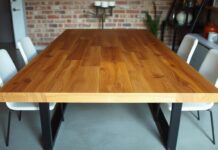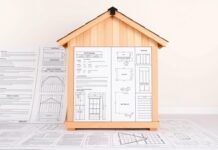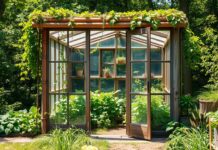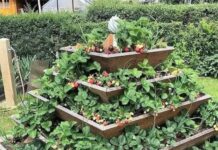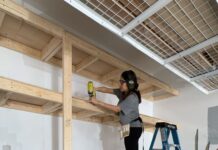Did you know a tunnel greenhouse can let you plant and sow 2-3 weeks earlier than open ground? For home gardeners, a DIY greenhouse breaks traditional limits.
With smart tips, even small spaces can thrive year-round. A mini greenhouse built from a shelving unit and plastic costs just $28, proving climate-adaptive gardening isn’t just for pros.
Building a DIY greenhouse under $4,000 is achievable using basic materials. Timber kits assemble in an afternoon, while old windows and plastic bottles double as insulation.
These hacks turn recycled items like plastic covers and raised beds with cloches into garden game-changers. Even a 8×10-foot setup can extend your growing season and shield plants from frost.
Today, affordable options like the $37 Portable Mini Greenhouse or $55 Garden Bed model make DIY garden projects accessible.
Experts recommend prioritizing ventilation—openings on all sides prevent overheating—while smart designs like lean-to greenhouses use walls for extra warmth.
Whether you’re a novice or expert, these hacks transform any space into a productive oasis.
Key Takeaways
- DIY greenhouses can cost as little as $28 using recycled materials like plastic bottles or shelving units.
- Proper ventilation with side openings keeps plants healthy and extends growing seasons by 2-3 weeks.
- Climate-adaptive gardening lets you grow year-round, even in winter with heating for fragile plants.
- Portable options like the $150 Walk-in Greenhouse (17% off) avoid permits and fit tight budgets.
- Expert tips include using old windows for cold frames and zippered designs for airflow control.
Understanding the Benefits of Your Own DIY Greenhouse
Building a DIY greenhouse brings many greenhouse benefits to your gardening. It extends growing seasons and cuts down on pests.
You can grow plants all year, even in cold winters or hot summers.
Year-Round Growing Potential
Tim Rumball, a gardening expert, says, “All garden plants benefit from a bit of protection, even in late winter and spring.” A greenhouse lets you start seedlings early.
This means you can have tomatoes in January or roses in December.
Homeowners save 30% on grocery bills by growing their own food all year.
“A small 200-square-foot greenhouse may cost between $1,000 and $7,000,” says the National Association of Landscape Professionals. But, DIY methods can cut costs by up to 50%.
Protection from Extreme Weather Conditions
Severe weather no longer means losing your crops. A well-built greenhouse protects against hail, frost, and high winds. It acts as a shield for your plants.
In areas like the Midwest, this weather protection can increase plant survival by 40%.
- Blocks ice storms with polycarbonate panels
- Blocks 90% of damaging UV rays in summer
- Reduces wind damage by up to 75%
Controlling Pests Naturally
DIY greenhouses make natural pest control easier. Mesh screens keep aphids out, and companion planting keeps beetles away.
One study found DIY greenhouses use 60% less chemicals than open gardens.
Introducing ladybugs or neem oil is simpler in these spaces. This keeps your garden balanced without harsh chemicals.
These DIY greenhouse advantages also make plants more resilient. Good airflow and regular checks can reduce pests by 80%.
This shows natural methods work best with smart design.
Essential Tools and Materials for Building Your Greenhouse Project
Starting a greenhouse project means picking the right greenhouse building materials and DIY greenhouse tools.
Whether it’s a small cold frame or a big walk-in space, choosing affordable and strong options is crucial. Begin by collecting greenhouse construction supplies that match your budget and climate.
Many DIYers opt for affordable greenhouse materials like PVC pipes or recycled wood to save money without losing quality.
- Tools: You’ll need a drill, saw, level, utility knife, and measuring tape.
- Framing: Go for pressure-treated wood, galvanized steel, or aluminum for lasting strength. PVC pipes are great for smaller projects.
- Coverings: Polycarbonate panels last long and protect from UV rays. Polyethylene sheeting is cheaper. You can also use old windows or recycled plastic bottles for unique coverings.
“Polycarbonate panels are backed by warranties lasting up to 15 years, making them a smart long-term investment.”
Use recycled materials like scrap wood or old windows to save money. Recycled greenhouse materials like plastic barrels or pallets can make creative frames.
For tools, think about renting power drills or saws if you don’t have them.
Always wear safety gear—gloves, goggles, and sturdy boots—when cutting or handling sharp edges.
Look for greenhouse construction supplies on sale at local hardware stores.
Kits from brands like Greenhouse Megastore or Giani come with pre-cut frames and polycarbonate sheets, making it easier to build.
Choose lightweight materials like aluminum if you’re building in windy areas.
Choosing the Perfect Location for Your DIY Greenhouse
Finding the right greenhouse location is key for healthy plants and easy upkeep. Look at sunlight, wind, and utility access.
A bad spot can hurt plant growth or make maintenance hard. Here’s what you need to know for optimal greenhouse placement based on your area and land.
Sunlight Considerations by Region
Make sure your greenhouse faces south for even light. In cold places (like Minnesota or Vermont), go for an east-west layout for more winter sun.
Warmer areas (like Texas or Florida) might do better with a north-south setup to avoid too much heat.
Try for 6 hours of winter sunlight a day. Use grow lights if it’s not enough. USDA says to use covers to shade plants in summer.
| Region | Optimal Orientation | Key Tip |
|---|---|---|
| Cold Climates | East-West | Maximize winter sun |
| Hot Climates | North-South | Reduce midday glare |
Wind Protection Strategies
Protect your wind protection for greenhouses with plants or fences. Stay away from open fields to avoid damage.
Use strong frames (like galvanized steel) in windy areas. Make sure to follow local building codes for anchoring.
- Plant evergreen windbreaks 50-100 feet away from the structure
- Use reinforced corner joints for added stability
- Install roll-up sides for airflow control
Accessibility Factors
Make sure your greenhouse accessibility makes daily tasks easy. Keep it close to water to avoid carrying it.
Leave enough space around for upkeep. Many people save time by adding plumbing for sinks.
“A well-placed greenhouse should feel as accessible as your backyard shed.” – John Smith, Oregon State Extension Service
Before digging, check for utility lines. Plan to spend $500-$5,000 on site prep. Make sure it’s close to electricity for heaters or fans.
Budget-Friendly Greenhouse Frame Options
Building a cheap greenhouse frames doesn’t mean you have to give up quality. Start with a DIY greenhouse structure using stuff you already have at home.
For example, turn a shelving unit into a cold frame by covering it with plastic sheeting.
This affordable greenhouse construction method costs under $100 and takes just two hours to assemble.
- PVC pipe frameworks: Use 1-inch PVC pipes ($8 for four sections) and elbow connectors ($4 for four) for lightweight, adjustable structures.
- Wooden frames: Build rectangle-shaped beds with 2×4 lumber for durability in snowy regions.
- Recycled greenhouse materials: Salvage window frames or pallets for siding. A 10×20-foot greenhouse can cost as little as $20.50 using thrifted materials.
“A 6-mil plastic sheet costs $13.50 and lasts longer than 3.5-mil options in windy areas.”
To save even more, borrow tools like hack saws and use dollar-store zip ties. For recycled greenhouse materials, use old shower curtains or fishing netting as temporary covers.
Test greenhouse frame designs like A-frames for small spaces or lean-to’s attached to existing fences.
Choose weather-resistant options—reinforced plastic withstands storms better than 4-mil alternatives.
With these tips, even a 10×20-foot setup can stay under $200 while growing tomatoes or root vegetables year-round.
Smart Covering Materials for Different Climate Challenges
Choosing the right greenhouse covering materials is key to keeping plants healthy all year. Materials must handle light, temperature, and durability well.
Whether it’s cold or hot, there’s a solution for every climate. An image showing different materials can be seen here:
Cold Climate Solutions
In cold areas, cold weather greenhouse covers like double-walled polycarbonate panels or bubble-insulated films are essential.
Thermal foils in Almeria greenhouses can raise nighttime temperatures by 2-3°C. Tim Rumball suggests using soil-staked pegs to secure lightweight covers:
“Light plastic structures will blow away in strong winds. Use wire pegs and weigh edges with stones.”
Layered fabrics and thermal blankets also help keep things warm without blocking sunlight.
Hot Climate Considerations
In hot places, hot climate greenhouse materials like aluminized shade cloths help keep things cool. Reflective coatings on polycarbonate reduce UV rays while still letting in light.
In the Mediterranean, double-inflated PE covers are popular, making up 65% of U.S. greenhouses.
Whitewash coatings save water but might cut PAR light by 10-15%, affecting crops like tomatoes.
Humidity Management Materials
To manage too much moisture, use breathable humidity control in greenhouses systems. Anti-condensation films and perforated plastics let air flow without drafts.
Temporary screens, like those in passive greenhouses, can create a 1.5°C temperature difference.
Pair these with vents or dehumidifying fabrics to stop mold. Choose materials that balance humidity and light, like semi-permeable ETFE films.
Innovative DIY Greenhouse Ventilation Systems
Effective greenhouse ventilation is key to preventing heat stress and mold. Start by selecting systems that balance cost and performance.
Solar-powered DIY automatic vents use wax actuators or bimetallic coils to open vents at 90°F (32°C), eliminating electricity needs.
A 18V solar panel ($25–$30) powers these setups, while a $10 eBay anemometer monitors wind speed.
“Proper airflow prevents temperature swings and disease, ensuring year-round growth.” – University of Arizona Agricultural Extension
Automatic Vent Controls Made Simple
For no-electricity setups, pair a solar cell with a wax-driven actuator. A 3A-rated motor (peaking at 10A) opens vents using a 15A fuse (better than 30A for longevity).
Use 16AWG copper wires to avoid corrosion, replacing plastic cups every 2 years. The Arduino Pro Mini controller costs under $20 and connects to limit switches for precise vent positioning.
Optimizing greenhouse airflow
- Position intake vents 2 feet above ground, paired with roof vents for convection currents
- Install a continuous fan running at 12V to circulate air, reducing mold risks
- Use a handheld anemometer to map airflow patterns monthly
Pair vents with reflective shade cloth in summer to enhance passive greenhouse cooling. Adjust vent spacing based on your structure’s size—1 actuator per 2 windows works best.
Adapting to seasonal ventilation needs
In summer, set vents to open at 85°F and use 2-inch roof slopes for rain runoff. Winter requires smaller vents left cracked 1–2 inches to retain heat.
Test vent positions quarterly using a digital thermometer with humidity tracking. Reduce fan speed in cold months to conserve warmth.
Proper greenhouse ventilation systems cut energy costs while protecting plants.
Prioritize durable materials like stainless steel hardware and UV-resistant plastics to extend component lifespan.
Regular inspections of vent mechanisms ensure they function during temperature shifts.
Water-Wise Irrigation Solutions for Greenhouse Gardens
Water conservation in greenhouses begins with smart irrigation choices. DIY drip irrigation and self-watering systems save water and keep plants healthy.
First, decide between manual watering or greenhouse irrigation systems that automate.
Solar-powered kits from DripWorks make scheduling easy with timers for exact water amounts.
- Use soaker hoses with low pressure (10–25 psi) for even coverage. Keep runs under 150 feet to avoid clogs.
- Install Ollas, unglazed clay pots, buried near roots. They release water slowly through porous walls, cutting overwatering risks.
- Build a drip system with 200 feet of tubing and 50 emitters for greenhouses up to 18’ wide. Pair with a solar-powered pump and 30-psi pressure regulator for off-grid setups.
Self-watering systems like wicking beds use mats to pull moisture from reservoirs.
Add mulch to keep soil moist, reducing evaporation by up to 50%.
For hard water, use a carbon filter to prevent clogs. Test soil often—most plants prefer moist, not soggy, soil.
Methods like rainwater harvesting and graywater recycling save money. A 26’ Growing Dome needs a 100-amp battery, solar panel, and timer for automation.
Water plants once a week in cool months, twice in summer. Raised beds deeper than 18” hold moisture longer than containers.
Temperature Regulation Hacks from Professional Growers
Mastering greenhouse temperature control is a mix of science and practical tips. BC Cross Country greenhouses use buried soil beds to keep lemons and Echeveria at 41°F.
This shows how experts keep plants happy all year.
“A passive solar greenhouse design can reduce heating costs by up to 40% through smart orientation and insulation.” – USDA Sustainable Agriculture Research & Education
- Position greenhouses to face south for maximum winter sun exposure
- Use bubble wrap insulation on north walls to trap heat
- Install black pipes filled with water along greenhouse floors to absorb daytime heat
Here are some greenhouse cooling methods:
- 30-50% shade cloth blocks intense summer sun
- Evaporative pads cool air by up to 15°F when paired with ventilation fans
- Set shutter exhaust fans to trigger at 85°F for automatic cooling
Here’s how to use thermal mass for greenhouses:
- Placing 55-gallon water barrels near plant beds
- Adding stone pathways to absorb daytime heat
- Using soil-filled raised beds to stabilize temperatures
Experts at BC Cross Country get great results by combining these methods. They use wireless sensors to keep temperatures right for most vegetables.
USDA data shows greenhouses can save 30% on heating costs.
NRCS grants can help pay for natural ventilation upgrades. It’s key to follow professional growing techniques.
This includes opening vents at night and removing frost blankets on sunny days to use the sun’s heat.
Sustainable Practices for Greenhouse Soil and Plant Management
Keeping greenhouse soil health in check is crucial to avoid nutrient shortages. Regular soil tests help catch problems early.
For example, carrots with cracks or leaves turning yellow mean something’s off.
Farmers in Maryland have seen great results with Biofert organic fertilizer. It helps balance the soil, reducing the need for synthetic nitrogen.
“Crop rotation boosts soil microbes, with studies showing 8.9x more bacteria in 9-year rotations,” says the USDA Sustainable Agriculture Research & Education (SARE) program.
| Re-Cropping Years | Yield (kg/m²) |
|---|---|
| 0 years | 12.76-12.39 |
| 1 year | 15.32-11.36 |
| 4 years | 9.65-8.23 |
| 8 years | 7.86-8.36 |
Rotating crops yearly helps avoid soil depletion. Using cover crops for greenhouses like field peas or clover adds nitrogen back into the soil.
The USDA found that sustainable greenhouse gardening methods can increase yields by 20% compared to traditional farming.
- Apply compost teas or worm castings instead of chemicals
- Plant tomatoes followed by legumes to balance soil microbes
- Test soil every 2 years to track nutrient levels
Choosing organic greenhouse practices also reduces methane emissions from too much fertilizer. Combining greenhouse plant rotation with cover crops keeps the soil rich.
These methods ensure the soil stays fertile for a long time, without harming the environment.
Conclusion: Turning Your DIY Greenhouse Dreams into Reality
Imagine having a dinner party in the rain, but still serving fresh greens and tomatoes. This dream is within reach with DIY greenhouse planning.
First, find a spot that gets 6+ hours of sunlight a day. Use materials like polycarbonate panels for durability or PVC frames for a budget-friendly option.
Your greenhouse project success depends on a few key things. These include good ventilation, managing humidity and temperature, and more. We’ve covered these important points earlier.
Start your starting a greenhouse garden with easy crops like herbs or leafy greens. Focus on sustainable greenhouse growing by collecting rainwater, composting, and using beneficial insects for pest control.
Even a small lean-to can extend your growing season, and even-span designs offer flexibility.
Keep track of your garden’s health by checking soil moisture and CO2 levels regularly.
Stick to a maintenance routine like cleaning the glazing twice a year and adjusting vents every day.
Greenhouses have been around since ancient Rome, and today’s models are even more efficient.
Your greenhouse can be a place of food security and joy. Share your harvests, use vertical space, and enjoy the greenhouse gardening benefits of having food all year.
Start with a simple kit or a custom frame, and let your plants and passion grow. The first step is hard, but every seedling brings you closer to a garden that defies seasons.
Start today, and watch your efforts grow into a resilient, rewarding space.
Read Also: DIY Raised Garden, DIY Planter Box, DIY Chicken Houses, DIY Bonfire Pit.


